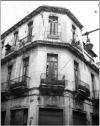Abstract
In the Historical Center of Havana, there is a large amount of buildings with a high grade of damages and the horizontal structureis one of the more affected elements. In this article the concepts of composite constructions are set foward, as well as theadvantages of their use in the recovery of buildings. The Cuban experience in the development of this typology is presented,and also its wide posibilities in the structural rehabilitation of different kinds of horizontal frames. It is introduced the experienceof rehabilitation in one building, in wich this concepts were applied, as well as the perspectives of coming after in thestudy of this technology.Apuntes is registered under a Creative Commons Attribution 4.0 International Public License. Thus, this work may be reproduced, distributed, and publicly shared in digital format, as long as the names of the authors and Pontificia Universidad Javeriana are acknowledged. Others are allowed to quote, adapt, transform, auto-archive, republish, and create based on this material, for any purpose (even commercial ones), provided the authorship is duly acknowledged, a link to the original work is provided, and it is specified if changes have been made. Pontificia Universidad Javeriana does not hold the rights of published works and the authors are solely responsible for the contents of their works; they keep the moral, intellectual, privacy, and publicity rights.
Approving the intervention of the work (review, copy-editing, translation, layout) and the following outreach, are granted through an use license and not through an assignment of rights. This means the journal and Pontificia Universidad Javeriana cannot be held responsible for any ethical malpractice by the authors. As a consequence of the protection granted by the use license, the journal is not required to publish recantations or modify information already published, unless the errata stems from the editorial management process. Publishing contents in this journal does not generate royalties for contributors.


